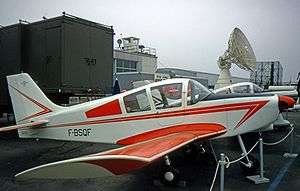Gazuit-Valladeau GV-1020
| GV-103 Gazelle | |
|---|---|
 | |
| The first GV-1020, exhibited at the 1971 Paris Air Show | |
| Role | light touring aircraft |
| National origin | France |
| Manufacturer | Gazuit-Valladeau |
| Designer | Georges Gazuit |
| First flight | 1 May 1969 |
| Number built | at least 7 |
|
| |
The Gazuit-Valladeau GV-103 Gazelle was a French-built light two- to four-seat training, aerobatic and touring aircraft of the late 1960s.
Design and development
The first GV-103L, as it was originally called, was a two- or three-seat light touring aircraft first flown in 1969. Later referred to as the GV-103 and powered by an 86 kW (115 hp) Lycoming O-235 flat-four engine, it led to several production variants with two, three and four seats using engines of increasing power within the same airframe. It had a side-by-side seating layout and a fixed tricycle undercarriage with a longer nosewheel which gave the aircraft a pronounced tail-down attitude on the ground. Its construction was primarily metal but included some glass fibre structures and plastic bonding, novel at the time.[1][2]
First flown on 1 May 1969, the GV-103 first appeared in public at the Paris Air Show in June 1969. The first two-seat production prototype GV-1020 Gazelle was on display at the Paris 1971 Show. It was intended to meet a club market for basic and aerobatic training.[1][2]
The second Gazelle to fly was the prototype of the four-seat GV-1031 tourer, powered by a 112 kW (150 hp) Lycoming O-320 flat-four engine.[1] An intermediate, three-seat variant with a Rolls-Royce built 97 kW (130 hp) Continental O-240 engine was planned[1] but may not have been built. A four-five seat variant with a 134 kW (180 hhp) engine and retractable undercarriage was also planned, and feasibility studies of a twin-engine version made, but neither reached the construction stage.[2]
Operational history
By November 1972 seven Gazelle prototypes were flying and the GV-1301 received its French certification in April that year, with the CV-1020 expected to follow in January 1973. The GV-1020 had only a short operational career and was no longer on the French civil aircraft register by January 1983,[3] though two GV-1031s, one dismantled, remained registered in mid-2010.[4] In 1970 plans for the Canadian company Mondair Aviation to build the Gazelle range under licence as the Mondair 115/130/150 were announced.[1] One GV-1031, without engine, reached Canada,[5] but no North American production followed.
Variants
- GV-103L
Later GV-103. First prototype, two-three seat, 85.7 kW (115 hp) Lycoming O-235 powered.[1][2]
- GV-1031
Second prototype and production four-seat tourer, 112 kW (150 hp) Lycoming O-320 powered. At least two built, one going to Canada.[1]
- GV-1020
Production two-seat aerobatic and basic trainer, 85.7 kW (115 hp) Lycoming O-235 powered.[1]
- GV-1032
Three seat, Rolls-Royce built 97 kW (130 hp) Continental O-240. May not have been completed.[1]
Specifications
Data from Flight 30 November 1972[2]
General characteristics
- Crew: one
- Capacity: one passenger
- Length: 6.60 m (21 ft 8 in)
- Wingspan: 8.75 m (28 ft 8 in)
- Height: 2.50 m (8 ft 2 in)
- Wing area: 12.10 m2 (130.2 sq ft)
- Aspect ratio: 6.3
- Airfoil: NACA 23015[1]
- Empty weight: 525 kg (1,157 lb)
- Gross weight: 750 kg (1,653 lb)
- Fuel capacity: 90L (23.8 US gal; 19.5 Imp gal)[1]
- Powerplant: 1 × Lycoming O-235 4-cylinder horizontally opposed air cooled piston, 86 kW (115 hp)
Performance
- Maximum speed: 215 km/h (134 mph; 116 kn)
- Cruising speed: 190 km/h (118 mph; 103 kn) at 75% power
- Stall speed: 75 km/h (47 mph; 40 kn) full flaps
- Range: 750 km (466 mi; 405 nmi)
- Service ceiling: 3,500 m (11,483 ft)
- Rate of climb: 3 m/s (590 ft/min)
Notes
References
- Burnett, Ian P. (1983). Civil Aircraft Registers of France 1983. Air-Britain (Historians) Ltd. ISBN 0-85130-104-5.
- Partington, Dave (2010). European registers handbook 2010. Air Britain (Historians) Ltd. ISBN 978-0-85130-425-0.
- Taylor, John W R (1972). Jane's All the World's Aircraft 1972-73. London: Sampson Low, Marston & Co. Ltd. ISBN 0-354-00109-4.
- "Gazuit Gazelle.". Flight. Vol. 3324 no. 102. 30 November 1972. pp. 777–8.
External links
| Wikimedia Commons has media related to Gazuit-Valladeau GV-1020. |